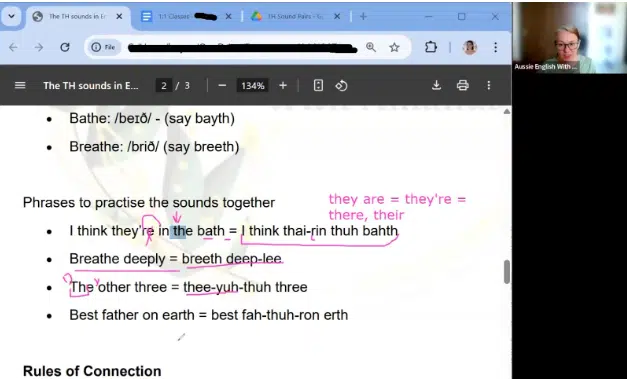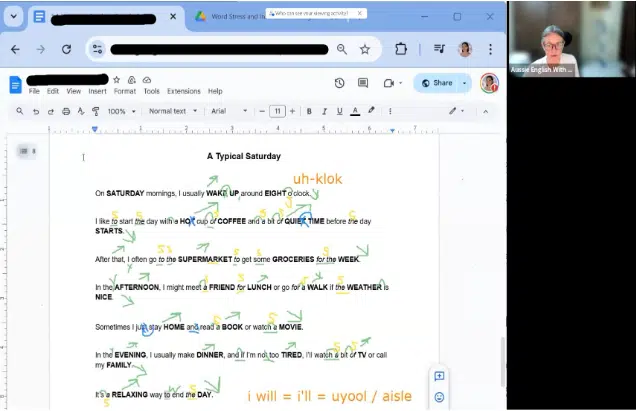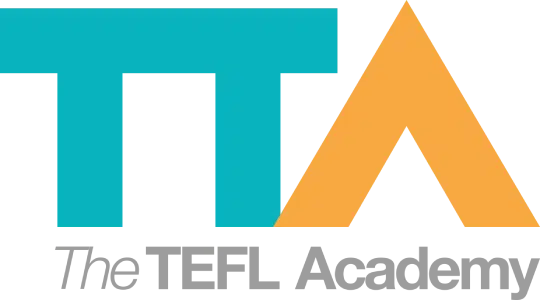How To Teach Pronunciation Online Like A Pro
Table of Content
- Introduction
- Pronunciation teaching
- Why pronunciation is tricky
- Where to focus
- Best practices
- Tools and resources
- Lesson ideas and activities
- Common pitfalls
Many people assume that if you can speak English, you can teach it. That’s like saying if you binge Netflix, you’re ready to direct a series. Being fluent in English doesn’t mean you can explain all the rules or why things are said a certain way, especially when it comes to the more technical aspects of the language.
Read more: Common TEFL Myths Busted
Pronunciation often gets pushed aside, even though it’s central to both speaking and listening. It’s also one of the trickiest skills to teach, especially online. But when taught well, it can seriously boost a student’s clarity, confidence, and connection to English.
So, what does effective pronunciation teaching look like online? We asked TTA alumna Amanda, a Certified Accent Specialist, to share how she does it — and how you can, too.
Pronunciation teaching, straight from an expert
I’ve been an ESL teacher for almost five years. I have a Level 5 Diploma from The TEFL Academy, and I’m a Certified Accent Specialist through The Accent Channel. As a Certified Specialist, I’ve undergone extensive training in accent modification and pronunciation training. I assess individual speech patterns, identify areas for improvement, and create customised training programs based on each student’s goals.
I left online platforms over a year ago, and I now teach full-time independently. My students come from Asia, Europe and South America, and most of them come to me specifically to improve their accents and pronunciation for life in Australia.

Why is pronunciation so tricky? (and important)
Students struggle so much with pronunciation because English is not a phonetic language. Most students expect that the written letters will match the sounds, but that’s rarely the case. The English alphabet was designed for reading and writing, not for speaking and listening.
Take the letter C, for example. No sound directly matches “C”. It can sound like /k/ (cat) or /s/ (city). Then you’ve got silent letters and spelling differences between American and British English, like ‘colour’ vs ‘color’ or ‘customise’ vs ‘customize’, which makes it even more confusing.
Read more: Why Is English So English?

Practising the ‘TH’ sound
Pronunciation is such an important skill to teach because it’s essential for:
- clear communication,
- conveying messages accurately, and
- building confidence.
Good pronunciation helps people understand each other and avoid misunderstandings. Teaching it online also opens up access to more students. If pronunciation were only taught in person, fewer people would have the opportunity to improve it.
- Top tip: Plan appropriately: Don’t forget about pronunciation in your planning. If you are teaching vocabulary with problematic sounds or a dialogue which depends on stress and intonation, plan applicable activities.
Teaching English is all about communication. Pronunciation is a major part of that. If our students have trouble with pronunciation, then they have problems with communication – it’s as simple as that.
What areas of pronunciation should you focus on?
I create customised learning plans for each student, so the individual sounds we work on vary from person to person. But no matter who I’m working with, I always include connected speech, rhythm, stress and intonation. These are key for helping students sound more natural in English and building confidence in real conversations.
Top tip: Keep it real: Use real-world language examples and authentic language to illustrate the pronunciation issue at hand. This will make it more understandable for your students.
For accent training, my lessons are a mix of:
- Learning how to make the sound
- Listening discrimination (for example, minimal pairs)
- Word and sentence drills
- Connection rules for that sound
- Speaking practice and activities
Read more: 6 Pronunciation Terms You Should Know

Some students don’t want to focus on individual sounds. They want to improve their overall pronunciation.
- Top tip: Predict pronunciation errors: With experience, you should be able to predict certain errors certain students will make with language. Consider this during your lesson planning so that you can prepare appropriate activities beforehand.
For these students, we do a lot of reading practice using different types of text. I give feedback on mispronunciation, show them the correct pronunciation, and help them apply connected speech, rhythm, stress, and intonation to make the reading sound more natural.

Best practices for teaching pronunciation online
To teach pronunciation well online, you’ve got to keep it relevant, doable, and fun. Amanda breaks down how she keeps students engaged, sets clear goals, and makes sure practice sticks—both in and out of class.
I always try to make lessons as relevant as possible to each student. For example, we might practise reading from a menu at their favourite restaurant, pronouncing customer names or medical terms (for doctors), or reading local news articles to stay up to date with current affairs.
I also give homework. It depends on what we’ve covered in class. Sometimes it’s word lists or drills for a target sound. Other times it’s reading a short story out loud. A few times during a package, I give them an assignment where they record themselves speaking freely using a prompt. Then I give feedback on pronunciation, intonation, stress, rhythm, and so on.
All of my students are on WhatsApp, so I ask them to send recordings that way. It’s easy and convenient.
I’m also very clear and honest upfront. Some students want quick results, but I tell them straight away that this only works if they also put in effort outside of class. After our intro call, I share the following outline:
Practice outside of lessons
To support your learning between classes, aim for 10–15 minutes per day of the following:
- Listening practice: Watch Australian TV shows or listen to podcasts relevant to your field (e.g. counselling, legal, healthcare).
- Shadowing: Choose short native-speaker clips and immediately repeat what you hear.
- Reading aloud: Practice reading legal texts, emails, or news articles out loud. This is especially helpful when reading to your kids.
Estimated progress
- 3–6 months: Noticeable improvement in pronunciation, clarity, and rhythm
- 1–2 years: Greater fluency and natural-sounding conversations
- Long-term: Master native-like intonation and connected speech
Setting those expectations early has helped me build trust and keep students motivated. They know it’s not a magic fix, but a consistent process.
Top tip: Revise, revise, revise: Just like any other language point, pronunciation needs to be revised again and again.
Consistency matters. Pronunciation doesn’t need to dominate every lesson, but it should be revisited often in different ways.

Tools and resources that help
Since I focus on Australian English and there aren’t many resources out there, I decided to create my own learning resources. Last year, I released an all-in-one Australian English course focused on pronunciation, so I share materials from that with my students. These include minimal pair videos, worksheets with drills for every sound in English and connected speech, audio recordings, charts, and more.
All our lessons are recorded, and I send a download link afterwards so students can review the lesson anytime. I also record homework materials. For example, if they’re asked to read a monologue, I’ll record myself reading it too so they can shadow the pronunciation.
Before I made my own materials, I used this minimal pairs site. I also use the Macquarie Dictionary (for Australian IPA) and compare it with the Cambridge Dictionary (UK/US IPA) when needed. I sometimes use Youglish.com to show real examples of connected speech.

Lesson ideas and activity examples
Pronunciation activities should be short and enjoyable.
- Top tip: Every little bit helps: You don’t need to dedicate an entire lesson to one aspect of pronunciation. Instead, plan short but frequent activities to include in your lessons.
Amanda shares some of her fave exercises that help students build confidence and improve their pronunciation in a fun way.
Some of my go-to pronunciation activities include:
- Minimal pairs,
- Dialogues and repetition drills,
- Watching short clips from Australian TV shows, then shadowing part of the transcript together,
- Reading short stories aloud,
- Open-ended discussion questions at the end of class to encourage free talking,
- Picture-based storytelling: I show them an image and ask them to make up a story or describe something based on it.
Shadowing clips and picture-based storytelling both work really well with students. They’re fun, natural, and a great way to apply pronunciation in real-time speech.
Keeping lessons fun using games is a great way to practise tricky sounds while keeping the energy up. Here are a few simple games you can try in addition to the abovementioned activities:
- Pronunciation Bingo: Use bingo cards with words or phonemes featuring similar problem sounds. Students must identify them correctly to win.
- Odd One Out: Write groups of words sharing the same sound except one. Students race to spot the word with the different sounds.
- Memory Game: Students match pairs of rhyming words from cards, practising sound recognition in a playful way.
Common pitfalls to avoid
One mistake I see a lot is focusing only on the IPA. It’s a great tool and I do use it, but not every student knows how to read it. I break words down phonetically (how they sound) and then show the IPA as well for students who find it helpful.
For example: vegetable = say VEJ-tuh-buhl (/ˈvɛdʒtəbəl/)
Another mistake I made early on in one-on-one lessons was trying to teach every single sound in English. Honestly, it’s a waste of time. You’re better off doing an accent analysis at the start, identifying the student’s challenge areas, and creating a personalised plan based on that. It’s just like grammar — there’s no point teaching every rule. Focus on what that specific student actually needs.
Read more: What Is The IPA?
Also, don’t spend the whole lesson doing drills, drills, and more drills. Students switch off. It needs to feel connected to real life.
Teaching pronunciation online takes more than just winging a few drills, and Amanda’s approach proves that. Her lessons are built on expertise, but also on authenticity since it’s rooted in real life. Amanda’s approach shows what’s possible when teaching is consistent, personalised and student-centred.
You don’t need to reinvent your entire teaching style to get results when teaching pronunciation online. But with the right tools and mindset, you can help students speak with more confidence and enjoy the process.
Table of Content
- Introduction
- Pronunciation teaching
- Why pronunciation is tricky
- Where to focus
- Best practices
- Tools and resources
- Lesson ideas and activities
- Common pitfalls
Many people assume that if you can speak English, you can teach it. That’s like saying if you binge Netflix, you’re ready to direct a series. Being fluent in English doesn’t mean you can explain all the rules or why things are said a certain way, especially when it comes to the more technical aspects of the language.
Read more: Common TEFL Myths Busted
Pronunciation often gets pushed aside, even though it’s central to both speaking and listening. It’s also one of the trickiest skills to teach, especially online. But when taught well, it can seriously boost a student’s clarity, confidence, and connection to English.
So, what does effective pronunciation teaching look like online? We asked TTA alumna Amanda, a Certified Accent Specialist, to share how she does it — and how you can, too.
Pronunciation teaching, straight from an expert
I’ve been an ESL teacher for almost five years. I have a Level 5 Diploma from The TEFL Academy, and I’m a Certified Accent Specialist through The Accent Channel. As a Certified Specialist, I’ve undergone extensive training in accent modification and pronunciation training. I assess individual speech patterns, identify areas for improvement, and create customised training programs based on each student’s goals.
I left online platforms over a year ago, and I now teach full-time independently. My students come from Asia, Europe and South America, and most of them come to me specifically to improve their accents and pronunciation for life in Australia.

Why is pronunciation so tricky? (and important)
Students struggle so much with pronunciation because English is not a phonetic language. Most students expect that the written letters will match the sounds, but that’s rarely the case. The English alphabet was designed for reading and writing, not for speaking and listening.
Take the letter C, for example. No sound directly matches “C”. It can sound like /k/ (cat) or /s/ (city). Then you’ve got silent letters and spelling differences between American and British English, like ‘colour’ vs ‘color’ or ‘customise’ vs ‘customize’, which makes it even more confusing.
Read more: Why Is English So English?

Practising the ‘TH’ sound
Pronunciation is such an important skill to teach because it’s essential for:
- clear communication,
- conveying messages accurately, and
- building confidence.
Good pronunciation helps people understand each other and avoid misunderstandings. Teaching it online also opens up access to more students. If pronunciation were only taught in person, fewer people would have the opportunity to improve it.
- Top tip: Plan appropriately: Don’t forget about pronunciation in your planning. If you are teaching vocabulary with problematic sounds or a dialogue which depends on stress and intonation, plan applicable activities.
Teaching English is all about communication. Pronunciation is a major part of that. If our students have trouble with pronunciation, then they have problems with communication – it’s as simple as that.
What areas of pronunciation should you focus on?
I create customised learning plans for each student, so the individual sounds we work on vary from person to person. But no matter who I’m working with, I always include connected speech, rhythm, stress and intonation. These are key for helping students sound more natural in English and building confidence in real conversations.
Top tip: Keep it real: Use real-world language examples and authentic language to illustrate the pronunciation issue at hand. This will make it more understandable for your students.
For accent training, my lessons are a mix of:
- Learning how to make the sound
- Listening discrimination (for example, minimal pairs)
- Word and sentence drills
- Connection rules for that sound
- Speaking practice and activities
Read more: 6 Pronunciation Terms You Should Know

Some students don’t want to focus on individual sounds. They want to improve their overall pronunciation.
- Top tip: Predict pronunciation errors: With experience, you should be able to predict certain errors certain students will make with language. Consider this during your lesson planning so that you can prepare appropriate activities beforehand.
For these students, we do a lot of reading practice using different types of text. I give feedback on mispronunciation, show them the correct pronunciation, and help them apply connected speech, rhythm, stress, and intonation to make the reading sound more natural.

Best practices for teaching pronunciation online
To teach pronunciation well online, you’ve got to keep it relevant, doable, and fun. Amanda breaks down how she keeps students engaged, sets clear goals, and makes sure practice sticks—both in and out of class.
I always try to make lessons as relevant as possible to each student. For example, we might practise reading from a menu at their favourite restaurant, pronouncing customer names or medical terms (for doctors), or reading local news articles to stay up to date with current affairs.
I also give homework. It depends on what we’ve covered in class. Sometimes it’s word lists or drills for a target sound. Other times it’s reading a short story out loud. A few times during a package, I give them an assignment where they record themselves speaking freely using a prompt. Then I give feedback on pronunciation, intonation, stress, rhythm, and so on.
All of my students are on WhatsApp, so I ask them to send recordings that way. It’s easy and convenient.
I’m also very clear and honest upfront. Some students want quick results, but I tell them straight away that this only works if they also put in effort outside of class. After our intro call, I share the following outline:
Practice outside of lessons
To support your learning between classes, aim for 10–15 minutes per day of the following:
- Listening practice: Watch Australian TV shows or listen to podcasts relevant to your field (e.g. counselling, legal, healthcare).
- Shadowing: Choose short native-speaker clips and immediately repeat what you hear.
- Reading aloud: Practice reading legal texts, emails, or news articles out loud. This is especially helpful when reading to your kids.
Estimated progress
- 3–6 months: Noticeable improvement in pronunciation, clarity, and rhythm
- 1–2 years: Greater fluency and natural-sounding conversations
- Long-term: Master native-like intonation and connected speech
Setting those expectations early has helped me build trust and keep students motivated. They know it’s not a magic fix, but a consistent process.
Top tip: Revise, revise, revise: Just like any other language point, pronunciation needs to be revised again and again.
Consistency matters. Pronunciation doesn’t need to dominate every lesson, but it should be revisited often in different ways.

Tools and resources that help
Since I focus on Australian English and there aren’t many resources out there, I decided to create my own learning resources. Last year, I released an all-in-one Australian English course focused on pronunciation, so I share materials from that with my students. These include minimal pair videos, worksheets with drills for every sound in English and connected speech, audio recordings, charts, and more.
All our lessons are recorded, and I send a download link afterwards so students can review the lesson anytime. I also record homework materials. For example, if they’re asked to read a monologue, I’ll record myself reading it too so they can shadow the pronunciation.
Before I made my own materials, I used this minimal pairs site. I also use the Macquarie Dictionary (for Australian IPA) and compare it with the Cambridge Dictionary (UK/US IPA) when needed. I sometimes use Youglish.com to show real examples of connected speech.

Lesson ideas and activity examples
Pronunciation activities should be short and enjoyable.
- Top tip: Every little bit helps: You don’t need to dedicate an entire lesson to one aspect of pronunciation. Instead, plan short but frequent activities to include in your lessons.
Amanda shares some of her fave exercises that help students build confidence and improve their pronunciation in a fun way.
Some of my go-to pronunciation activities include:
- Minimal pairs,
- Dialogues and repetition drills,
- Watching short clips from Australian TV shows, then shadowing part of the transcript together,
- Reading short stories aloud,
- Open-ended discussion questions at the end of class to encourage free talking,
- Picture-based storytelling: I show them an image and ask them to make up a story or describe something based on it.
Shadowing clips and picture-based storytelling both work really well with students. They’re fun, natural, and a great way to apply pronunciation in real-time speech.
Keeping lessons fun using games is a great way to practise tricky sounds while keeping the energy up. Here are a few simple games you can try in addition to the abovementioned activities:
- Pronunciation Bingo: Use bingo cards with words or phonemes featuring similar problem sounds. Students must identify them correctly to win.
- Odd One Out: Write groups of words sharing the same sound except one. Students race to spot the word with the different sounds.
- Memory Game: Students match pairs of rhyming words from cards, practising sound recognition in a playful way.
Common pitfalls to avoid
One mistake I see a lot is focusing only on the IPA. It’s a great tool and I do use it, but not every student knows how to read it. I break words down phonetically (how they sound) and then show the IPA as well for students who find it helpful.
For example: vegetable = say VEJ-tuh-buhl (/ˈvɛdʒtəbəl/)
Another mistake I made early on in one-on-one lessons was trying to teach every single sound in English. Honestly, it’s a waste of time. You’re better off doing an accent analysis at the start, identifying the student’s challenge areas, and creating a personalised plan based on that. It’s just like grammar — there’s no point teaching every rule. Focus on what that specific student actually needs.
Read more: What Is The IPA?
Also, don’t spend the whole lesson doing drills, drills, and more drills. Students switch off. It needs to feel connected to real life.
Teaching pronunciation online takes more than just winging a few drills, and Amanda’s approach proves that. Her lessons are built on expertise, but also on authenticity since it’s rooted in real life. Amanda’s approach shows what’s possible when teaching is consistent, personalised and student-centred.
You don’t need to reinvent your entire teaching style to get results when teaching pronunciation online. But with the right tools and mindset, you can help students speak with more confidence and enjoy the process.
 United States
US
United States
US








